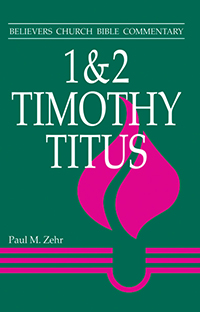Contextualizing the Gospel (in 1 & 2 Timothy, Titus)
![]() Home A B C D E F G H I J K L M N O P Q R S T U V W X Y Z Abbreviations Glossary
Home A B C D E F G H I J K L M N O P Q R S T U V W X Y Z Abbreviations Glossary
“Contextualizing the gospel” is terminology used in the missionary work of the Christian church to describe how the gospel communicates and takes root in a new culture. Missionaries try not to impose on one culture the moral and ethical norms considered “Christian” in another. When one keeps mission first, one can authentically make allowances for certain ethical practices until seasoned indigenous moral discernment can emerge. The author of the letters to Timothy and Titus indicates his contextualization of the gospel by the use of hina clauses and by borrowing terminology from contemporary culture and changing its content.
The Greek conjunction hina (so that, then) appears 15 times in 1 Timothy, 5 times in 2 Timothy, and 13 times in Titus. Certain behaviors are prescribed for the sake of the church and its mission. Apparently bad behavior on the part of some elicited negative reactions against the church in the pagan society. So the author of the letters to Timothy and Titus mutes the rights of Christians in their freedom in Christ for the sake of the gospel. By lessening freedom in some areas of behavior, the church was able to contextualize its life and message for a time and win over the unbelievers to Christ. The following teaching indicates this contextualizing process (with stress added for so that or then).
Teaching directed to slaves:
- Let all who are under the yoke of slavery regard their masters as worthy of all honor, so that the name of God and the teaching may not be blasphemed. (1 Tim 6:1)
- Tell slaves to be submissive in every respect; they are not to talk back, not to pilfer, but to show complete and perfect fidelity, so that in everything they may be an ornament to the doctrine of God our Savior. (Titus 2:9-10)
Teaching directed to bishops:
- Moreover, he must be well thought of by outsiders, so that he may not fall into disgrace and the snare of the devil. (1 Tim 3:7)
Teaching directed to young widows:
- Give these commands as well, so that they [the young widows] may be above reproach. (1 Tim 5:7)
Teaching directed to young women:
- being submissive to their husbands, so that the word of God may not be discredited. (Titus 2:5)
Teaching directed to young men:
- Likewise urge the younger men to be . . . a model of . . . sound speech that cannot be censured; then any opponent will be put to shame, having nothing evil to say of us. (Titus 2:6-8)
A second way the letters to Timothy and Titus contextualize the gospel is to fill terms used in the culture of the day with new Christian meaning. For example, Paul takes the terminology used in imperial religion and fills it with new meaning. For Paul, the gospel of Jesus Christ is God’s saving action in history and thus discounts the claims of the false gods of the empire [Names for God and the Imperial Cult, p. 357].
| —Paul M. Zehr |
